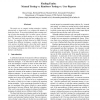Free Online Productivity Tools
i2Speak
i2Symbol
i2OCR
iTex2Img
iWeb2Print
iWeb2Shot
i2Type
iPdf2Split
iPdf2Merge
i2Bopomofo
i2Arabic
i2Style
i2Image
i2PDF
iLatex2Rtf
Sci2ools
ISSRE
2008
IEEE
2008
IEEE
Finding Faults: Manual Testing vs. Random+ Testing vs. User Reports
The usual way to compare testing strategies, whether theoretically or empirically, is to compare the number of faults they detect. To ascertain definitely that a testing strategy is better than another, this is a rather coarse criterion: shouldn’t the nature of faults matter as well as their number? The empirical study reported here confirms this conjecture. An analysis of faults detected in Eiffel libraries through three different techniques—random tests, manual tests, and user incident reports—shows that each is good at uncovering significantly different kinds of faults. None of the techniques subsumes any of the others, but each brings distinct contributions.
| Added | 31 May 2010 |
| Updated | 31 May 2010 |
| Type | Conference |
| Year | 2008 |
| Where | ISSRE |
| Authors | Ilinca Ciupa, Bertrand Meyer, Manuel Oriol, Alexander Pretschner |
Comments (0)

